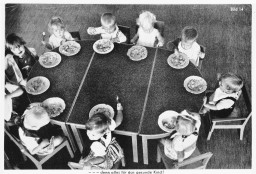
Photo
Browse an alphabetical list of photographs. These historical images portray people, places, and events before, during, and after World War II and the Holocaust.
<< Previous | Displaying results 176-200 of 228 for "Photo" | Next >>
-
Prewar photo of the extended Kracowski family
PhotoThe Kracowski family was living in Bialystok when German Order Police Battalion 309 killed 2,000-3,000 Jews on June 27, 1941. Dr. Samuel Kracowski was among the hundreds of Jews locked in the Great Synagogue and burned alive. After the Germans ordered the establishment of a ghetto in Bialystok, Samuel's wife, Esther, and children, Ewa and Julek, were given a room in the ghetto clinic. Photo dated September 1, 1935. Samuel and Esther are seated in the center, with Julek seated in the front row on the…

-
Prewar photograph of Berta and Inge Engelhard in Munich
PhotoPrewar family photograph of Berta and Inge Engelhard holding pigeons in a public square in Munich. Photograph taken in Munich, Germany, 1937. Following increased anti-Jewish measures, Berta and brother Theo (not pictured here) left Germany on a Kindertransport in January 1939. Inge followed on a different transport a few months later. While the siblings were eventually housed together in England, they faced many challenges during the war including the pain of separation from their parents. Parents Moshe…
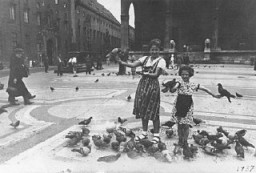
-
Prewar photograph of Terese Cohen with her two children
PhotoTerese Cohen, a Tunisian Jewish women, poses with her two children, Nadia and Marcel. Immediately after the Allied landings in Algeria and Morocco, the Germans occupied Tunisia. After the occupation, an SS officer came to the Cohen's house and confiscated everything leaving only the table and chairs for the Germans to use. They gave the family 24 hours to pack and leave and then expropriated the home to use as a barracks for soldiers.

-
Prewar portrait of Ala Gertner
PhotoPrewar photo of Ala Gertner. Bedzin, Poland, 1930s. After being deported to Auschwitz, Ala Gertner took fate into her own hands. Upon arrival, she was assigned to forced labor at a nearby armaments factory. After learning that they were going to be killed, Gertner, along with fellow female prisoners, began smuggling gunpowder and explosives from the factory with plans to destroy one of the crematoriums. During the uprising in October 1944, the prisoners killed three guards. They also set fire to…
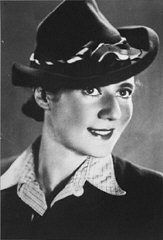
-
Prewar portrait of Basia and Moshe Golden
PhotoA prewar photograph of Basia and Moshe Golden (Gordon) taken ca. 1922–1925 in Swieciany, Poland (now Lithuania). Basia, along with two of their four children, Boruch and Teyva, were shot at the Ponary killing site by SS men and their Lithuanian collaborators in September 1943. Moshe died in the Klooga concentration camp. Two of their children survived, Niusia and Rwya. This photograph was saved by Niusia (now Anna Nodel) while she was in hiding.
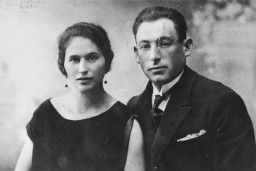
-
Prewar portrait of Dorrith Oppenheim
PhotoDorrith was born in Kassel, Germany, in December 1938. Her parents were Hans and Trudi Oppenheim. Following increased anti-Jewish measures, Dorrith was among the children sent on Kindertransports to find refuge in the United Kingdom. She left Germany on July 24, 1939. She never saw her parents again. They were deported to Auschwitz, where they perished in October 1944.
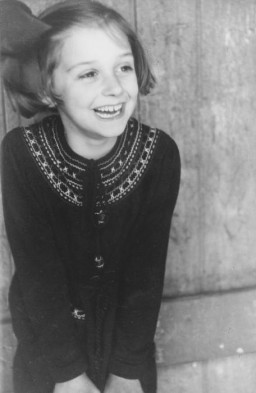
-
Prewar portrait of Golda Tenin with her daughter Paulina
PhotoPrewar portrait of Golda Tenin with her daughter Paulina, 1935. The Tenin family was living in the Ukrainian city of Odesa when it was occupied by Romania, an ally of Nazi Germany. In December 1941, Romanian authorities decided to make Odesa free of Jews. Two of Golda's children, Paulina and Rita, were murdered. Paulina was killed in January 1942, likely during deportation. Rita was killed after she was discovered in hiding with non-Jewish neighbors. Golda managed to survive.
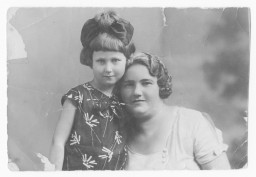
-
Prewar portrait of Pinchas and Roza Zygielbojm
PhotoPrewar portrait of Pinchas and Roza Zygielbojm taken in 1936 in Warsaw, Poland. In 1942, they were taken into the Ponary forest outside of Vilna and killed by the SS and Lithuanian collaborators. Born in 1906, Pinchas Zygielbojm was an actor and brother of Szmul Artur Zygielbojm, a leader of the Jewish socialist Bund in interwar Poland and later a member of the National Council of the Polish Government-in-Exile in London.
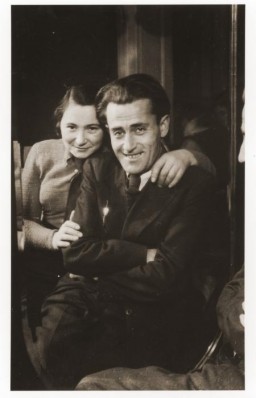
-
Prisoner shot near Gardelegen by the SS during a death march
PhotoAn American soldier kneels by the corpse of a prisoner on the roadside near Gardelegen. The prisoner was shot by the SS when he was too exhausted to continue on a death march. Germany, April 14-18, 1945.
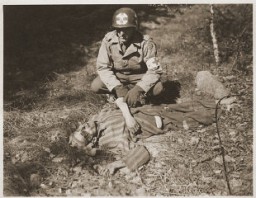
-
Prisoners arrested during the crackdown on political opponents
PhotoPrisoners arrested during the crackdown on leftists and other targeted groups exercise in the courtyard of the Alexanderplatz prison. Munich, Germany, April 10, 1933.
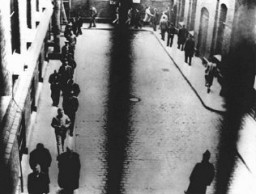
-
Prisoners arriving at the Belzec killing center
PhotoA column of prisoners arrives at the Belzec killing center. Belzec, Poland, ca. 1942. In early 1940 the Germans set up a forced-labor camp for Jewish prisoners in Belzec. The inmates were forced to build fortifications and dig anti-tank ditches along the demarcation line between Germany and Soviet-occupied Poland. The camp was closed down at the end of 1940. The following year, in November 1941, construction began on the Belzec killing center.
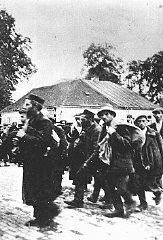
-
Prisoners at forced labor in Dachau
PhotoGerman Jews at forced labor in Dachau. Photo taken during an SS inspection. Dachau concentration camp, Germany, June 28, 1938.
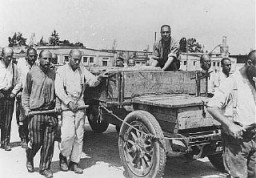
-
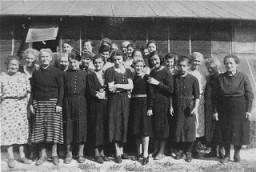
-
Prisoners' barracks in Dachau
PhotoView of prisoners' barracks soon after the liberation of the Dachau concentration camp. Dachau, Germany, May 3, 1945.
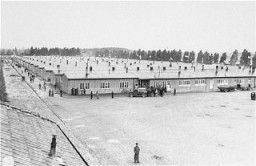
-
Prisoners in Plaszow
PhotoA group of women prisoners in the Plaszow camp. Plaszow, Poland, 1943-1944.
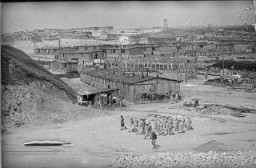
-
Prisoners in the Dachau camp
PhotoPrisoners carrying bowls in the Dachau concentration camp. Dachau, Germany, between 1933 and 1940.

-
Prisoners in the Gurs camp
PhotoCrowded living conditions: prisoners inside a barracks at Gurs detention camp. France, probably 1940.
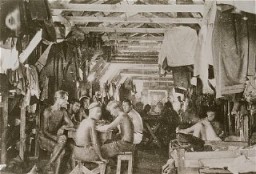
-
Prisoners in the roll call area at Melk
PhotoNewly arrived prisoners are assembled in the Appellplatz (roll call area) at the Melk camp, a subcamp of Mauthausen in Austria. 1944–45.

-
Prisoners in the Sachsenhausen camp
PhotoUniformed prisoners with triangular badges are assembled under Nazi guard at the Sachenhausen concentration camp. Sachsenhausen, Germany, 1938.

-
Prisoners of Sachsenhausen at forced labor
PhotoThe SS established the Sachsenhausen concentration camp as the principal concentration camp for the Berlin area. Located near Oranienburg, north of Berlin, the Sachsenhausen camp opened on July 12, 1936.

-
Prisoners of the Gestapo
PhotoPrisoners march in the courtyard of the Gestapo headquarters in Nuremberg. The original caption to the photograph reads: "The courtyard of the Gestapo headquarters, Nurnberg. These appear to be Frenchmen taken to Germany as slave laborers".
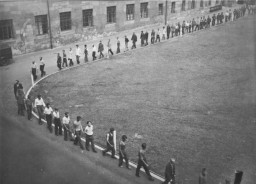
-
Professor Raphael Lemkin and Ricardo Alfaro of Panama
PhotoProfessor Raphael Lemkin, left, and Ricardo Alfaro of Panama (chairman of the Assembly's Legal Committee) in conversation before the plenary meeting of the General Assembly at which the Convention on the Prevention and Punishment of Genocide was approved.
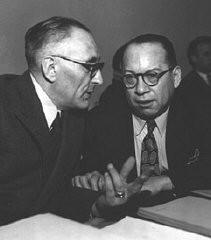
-
Pro-Hitler propaganda in Vienna
PhotoA streetcar decorated with swastikas passes billboards displaying Hitler's face. The billboards urge Austrians to vote "Ja" (Yes) in the upcoming plebiscite on the German annexation of Austria. Vienna, Austria, April 1938.

-
Pro-Hitler slogan displayed at the 1936 Olympic Games
PhotoAt a ceremony during the 1936 Olympic Games, German spectators spell out the phrase, directed at Adolf Hitler, "Wir gehoeren Dir" [We belong to you]. Berlin, Germany, August 1936.

-
Nazi propaganda depicting German children
PhotoIn this Nazi propaganda picture, young German children are shown eating a meal. The original caption reads: "Everything for the healthy child." Photo dated 1933–1943.
